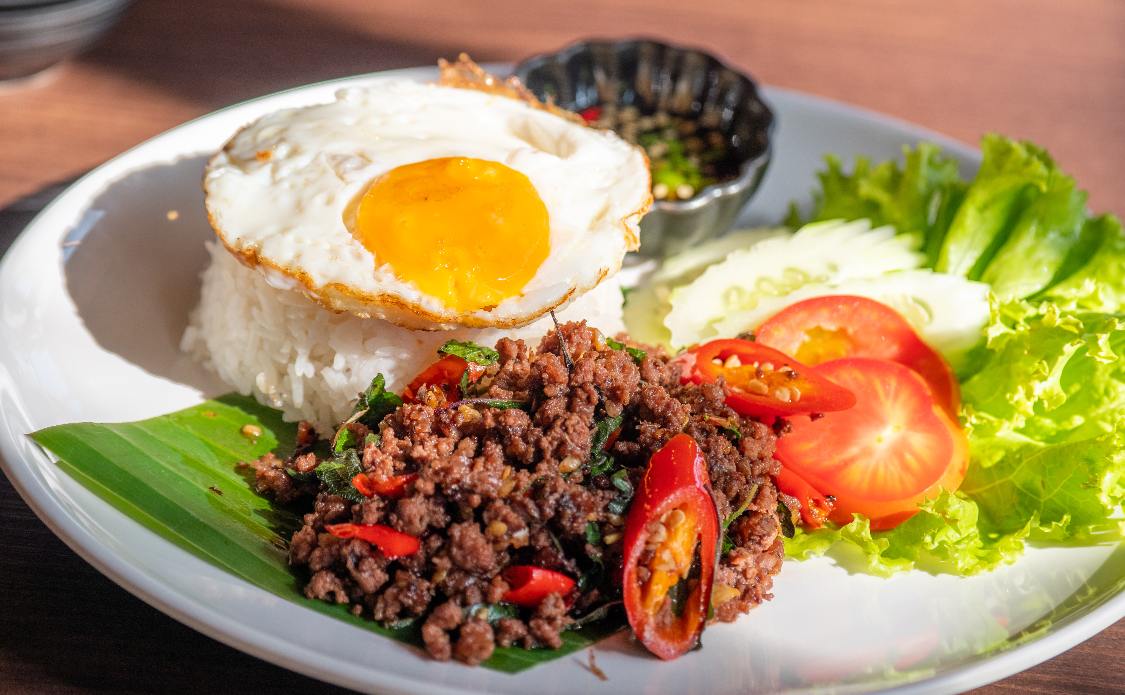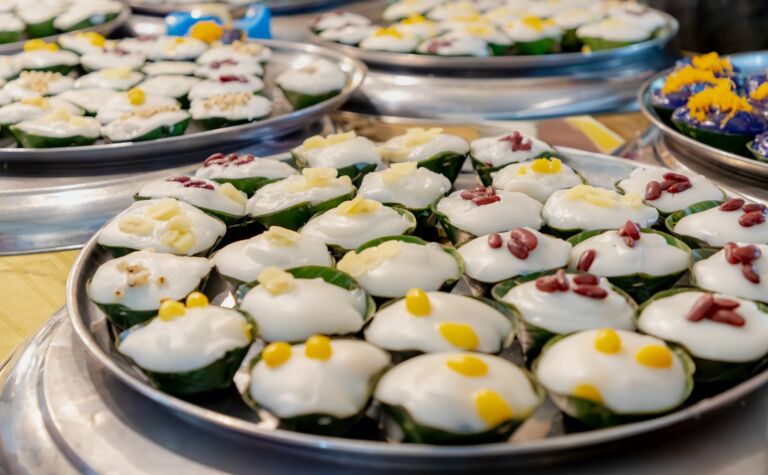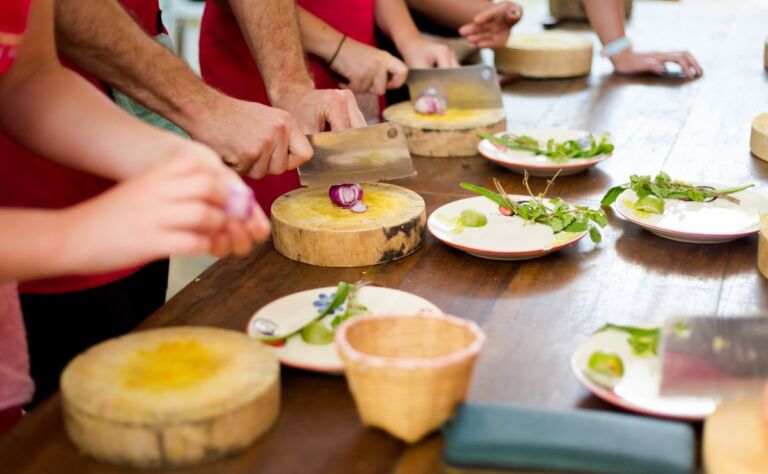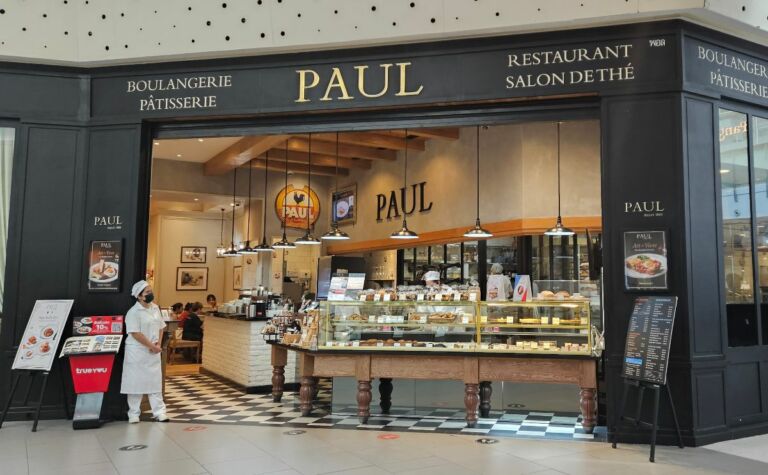An Ode To The (Not So) Humble Pad Kra PoW
Paula, Charles, and I have many things about Thailand that we agree on and some that we don’t. One thing we can unanimously concur is that Pad Kra Pow, Thailand’s flavour-packed stir-fry sensation, is the best dish to come out of Thailand, so we felt it only fitting that we dedicate an entire blog to this not-so-humble street food sensation.
You may also see pad kra pow spelt as pad ka prao, pad kaprao, or pad gaprao, it all tastes the same!
This page contains affiliate links. Please see our disclosure policy for more details.
A Brief History: The Origins of Pad KRa Pow
Pad Kra Pow, a culinary gem from Thailand, originated as a humble street food dish known for its simplicity and robust flavours. Traditionally designed to offer a quick, hearty meal, it features a spicy, fragrant stir-fry of meat or seafood, garlic, and holy basil, skilfully combined with fish sauce and chillies.
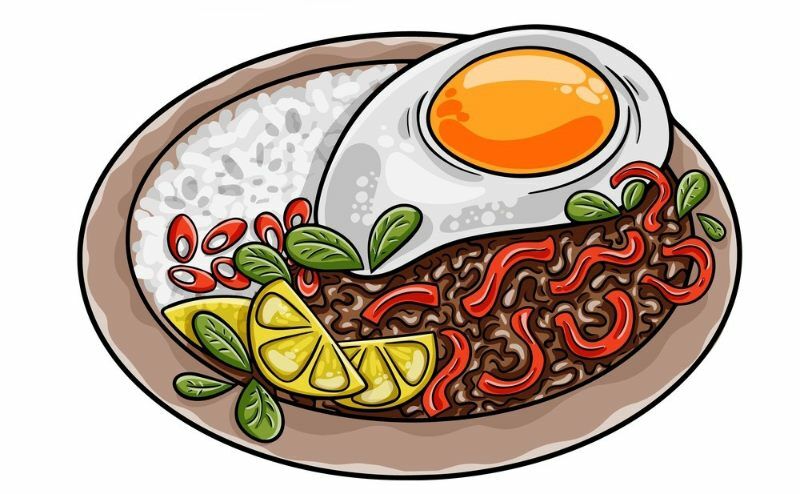
Over time, this dish has evolved from its modest beginnings into a beloved classic that graces both street stalls and high-end restaurants alike, embodying the vibrant spirit of Thai cuisine.
How I got introduced to it was when I first arrived in 2016 to do my TESOL certificate, and my teacher took me to a local restaurant and said to the server, “Just two Ka Praos with pork”. I asked him what it was, and he told me it’s what everyone eats anytime they can’t be bothered to make a decision. And he was right, so many of my Thai friend’s order it for that exact reason!
The Essential Ingredients of Pad KRa PoW
The magic of Pad Kra Pow lies in its simplicity and the harmony of its core ingredients. Every ingredient is pivotal in creating the dish’s unique flavour profile.
Garlic and Thai Chilis: These two components form the aromatic base of the stir-fry. Thai chilis, known for their intense heat, can be adjusted according to your tolerance for spice. Garlic, meanwhile, infuses the dish with a rich, spicy aroma. Traditionally, these are placed together in a mortal and pestle and pounded into a paste.
Lean meat: While minced pork is the most popular choice in Thailand, and it’s my personal favourite, chicken, beef, pork belly, crab, or tofu for a vegetarian alternative are all excellent options. If you’re going with ground meat, ensure it’s lean enough so it absorbs the sauces without becoming greasy.
Sauces: The combination of fish sauce, soy sauce, and oyster sauce balances saltiness, umami, and slight sweetness. Add a touch of sugar to round out the flavours and a squeeze of lime for a delicate tang. I’ve had people tell me it only needs fish sauce and nothing else, but that never tastes right to me. It sounds simple, but get the ratio of each sauce wrong, and it doesn’t taste how it should.
Holy Basil: This herb is the soul of Pad Kra Pow. With its peppery notes and a hint of anise, holy basil gives the dish its distinct aroma. If holy basil is hard to find, you can substitute it with Thai basil, which offers a similar but slightly sweeter flavour.
Eggs: Pad Kra Pow is traditionally served with a crispy fried egg on top (Khai Dao). The runny yolk mixes with the stir-fry, adding richness and an element of indulgence to the dish.
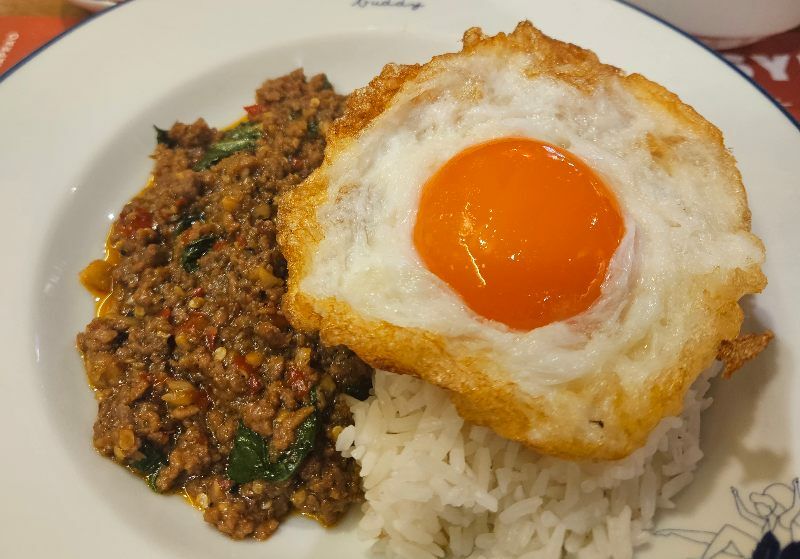
Some people like to add a variety of vegetables, like bell peppers, broccoli, or bamboo shoots, to add even more nutrition and texture to the meal. However, I’m not a fan; I believe it should only contain the above ingredients.
One of the wonderful things about the dish is that there’s not one hard or fast rule. You might go to the same restaurant three nights in row and order it, and it’ll taste slightly different each time.
Spice it Up: Customising the Heat Level to Your Taste
Customising the heat level in Pad Kra Pow can be an exciting culinary adventure. Traditionally, this dish packs quite the punch, thanks to an abundance of fiery Thai chillies.
I know for a fact that Paula loves to amp up the fire, while (despite being here for 8 years) I’m still yet to appreciate having my tongue burned to a crisp while my nose runs and my eyeballs feel like popping out. The beauty of home cooking allows me to tailor it precisely to my desired level of spiciness.
If you’re going to make this yourself, to help you choose the proper chilli, here’s a breakdown of five different types used in Thailand, listed in order of heat:
- Prik Chee Fah (Fah Pepper): mild and often used for its vibrant red colour rather than intense heat.
- Prik Chi Fa Daeng (Red Spur Chilli): slightly hotter with a sweet undertone, perfect for those who enjoy a moderate spice level.
- Prik Kaleang: these small, pale green or yellow chillies bring a moderate heat, ideal for balanced dishes.
- Prik Leung (Yellow Chilli): offers a noticeable heat, making it an option for those looking for something spicier.
- Prik Kee Noo Suan (Bird’s Eye Chilli): very hot and common in Thai cooking, these pack a serious punch and can easily elevate the spice level of any dish.
Red, green, yellow, or Bird’s Eye, it’s best to experiment with these tiny powerhouses to reach your optimal spice level.
Feel free to adjust the spice not just through the type of chilies used, but the quantity. Start with fewer chillies (I’m still at the single chilli stage, Paula is on four!) and gradually add more as your taste buds adapt. Remember, adding more heat than diluting it is always easier!
If, like me, you don’t like spicy, when you order it, just say Mai Pet (no spicy!). You’ll still experience the unique flavour base, just without the added heat.
Hitting the Streets: Where I Get My Pad Kra Pow
I’ve eaten Pad Kra Pow everywhere, from my own kitchen — in my opinion, my husband cooks the best version in Thailand, but then I am biased — to 5-star restaurants. What I’ve discovered is that the little local hole-in-the-wall type restaurants, where Grandma has been cooking it for 50+ years, are the best. These ladies have mastered the art of the dish, and I’m rarely disappointed.
Having said that, I’ve also had really good versions in shopping mall food courts. Surprisingly, the most disappointing for me are the 5-star restaurants, where I think they glamourise it more than it needs to be, and somehow, it lacks the traditional feel — maybe they only use fish sauce 😉 .
There are 77 provinces in Thailand and even though it’s my mission to eat Pad Kra Pow in every one of them, here are a few places worth visiting. I’ll keep adding to this list as I travel more.
Bangkok
I covered this in my Bangkok street food blog, and Paula is dead set on this being the best in the city — Ruam Sab Market in Khlong Toei.
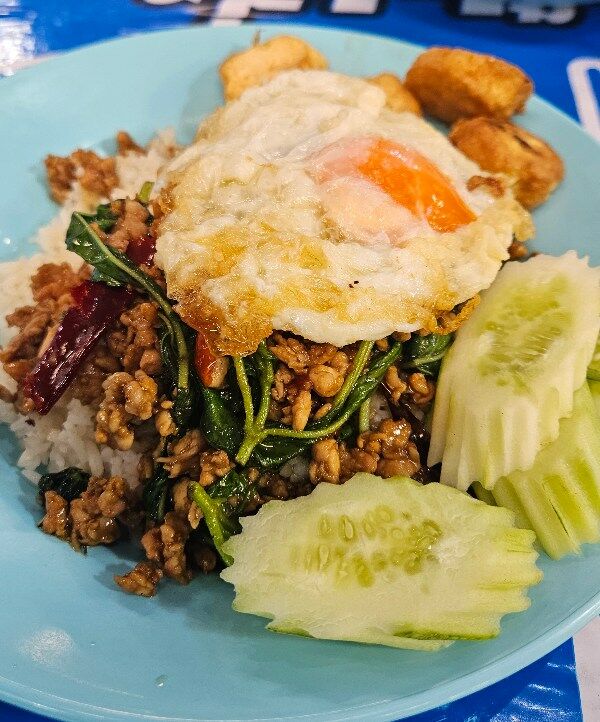
This centre provides lunch for daily office workers and is jammed packed from 11am till about 1pm. Arrive early for a seat. It’s just a few minutes’ walk from Pretchaburi MRT or the Saen Saep canal Asoke pier.
An honorable mention must go to Phed Mark, food vlogger Mark Wien’s restaurant in Ekkamai. It took me a few years to try this restaurant because I thought it was likely all hype. I was wrong, while it is an expensive version the quality is next level and I rate it up there in top 10 versions I have had.
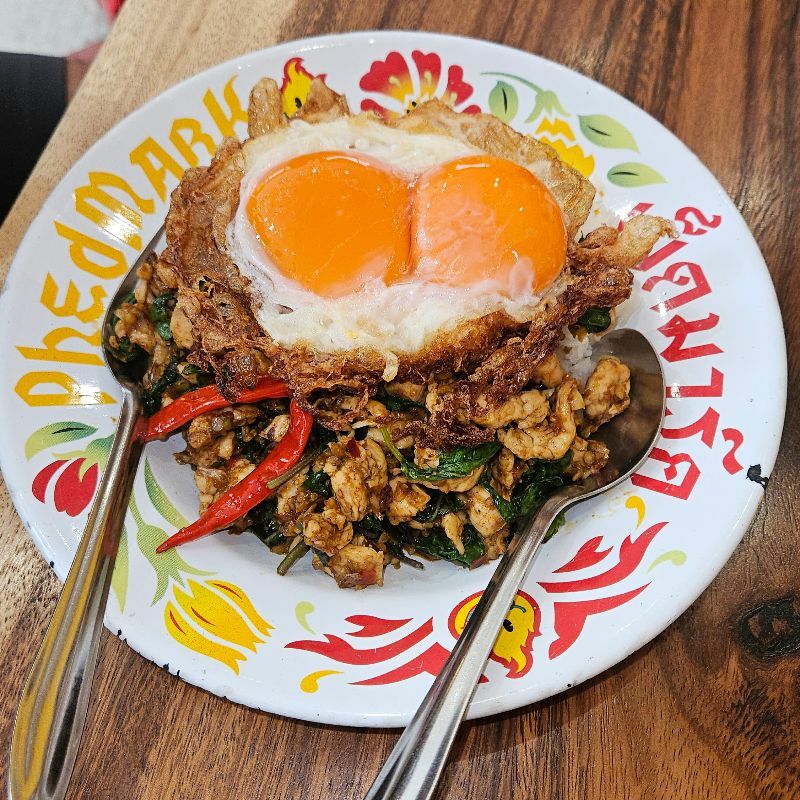
Nonthaburi
The neighbouring suburb of Bangkok is becoming very popular for expats, and my favourite place to eat Pad Kra Pow is at @SAIMA Park Avenue. The restaurant is called Hot Pan (Nai Pon), and it’s to the left as you walk through the front door.
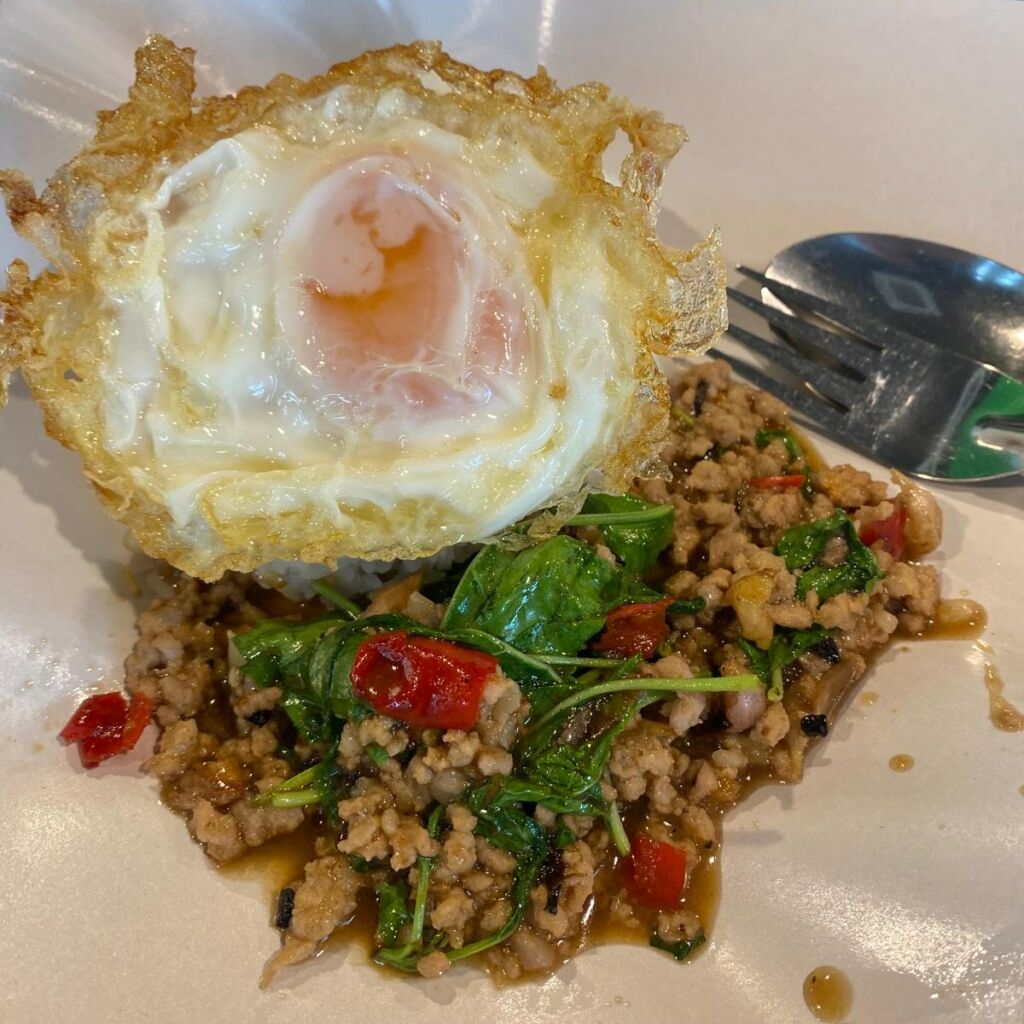
Hua Hin
This is a tough one, as both the shops selling two of the elevated Pad Kra Pows (see next section) are here, but my pick goes to the stall at Tamarind Market. It’s only open Thursday to Sunday night, but absolutely worth trying it when you’re there.
Gourmet Twists: Elevating Pad Kra Pow to New Heights
Ok, so before you go and call me a hypocrite, as I just said above that, Pad Kra Pow shouldn’t contain other ingredients; this next section isn’t that. It’s how I’ve seen it served in some restaurants as a base for a larger dish. The core elements remain the same; it’s just how it’s used that’s elevated.
Pad Kra Pow Pizza
The first time I ever saw this Thai stir fry dish upgraded was as a pizza selection. And it works! Let’s face it: you could put almost anything on a pizza and have a hit. The only thing here is that melted cheese over Pad Kra Pow isn’t ideal, so with minimal amounts, it works really well. Many pubs that serve Thai and Western food together will have this on the menu.
Pad Kra Pow With Japanese Curry
I found this on a menu and as a fan of Japanese Curry I figured it was worth a try. It’s an absolute hit! Surprisingly, the flavour of the curry compliments the Pad Kra Pow. However, as both were at the higher spice level, it was a little too hot for me. Fans of heat will find this combination a taste sensation.
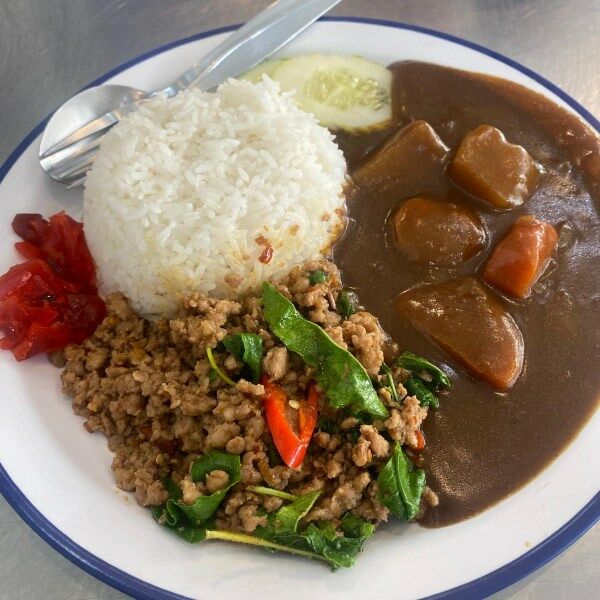
Scrambled Eggs With Pad Kra Pow
Two of the things I most love to cook/eat on the same dish seemed too good to be true. But it’s not. It’s absolutely amazing, the softness of the eggs goes exceptionally well with the coarse ground pork, and the combination of flavours is heavenly. If I could only ever eat my Ka Prao like this, I would in a heartbeat.
Pad Kra Pow Sandwich
I was very excited to see this on a menu and ordered it gleefully. It’s a great idea, but logistically it didn’t work. The minced pork just oozed out all over my fingers and fell onto the plate, leaving me with mouthfuls of bread and sauce.
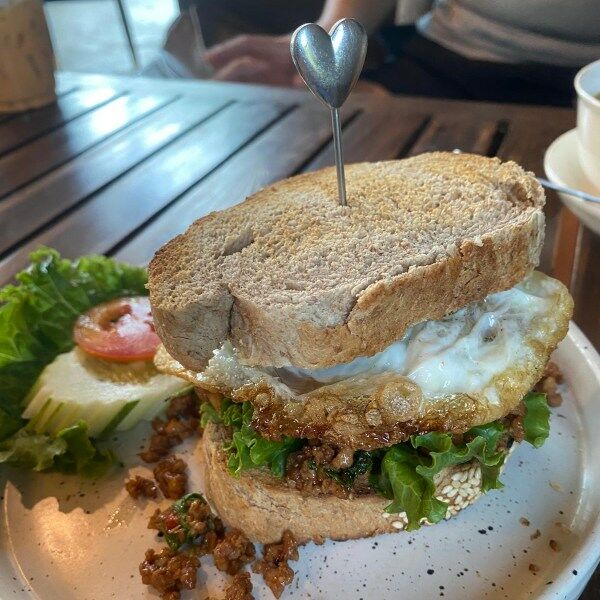
Eaten as an open sandwich with a knife and fork worked the second time — I’m not the kind of person who gives up easily — but it lost the eating with your hands concept that I love about sandwiches.
Pad Kra Pow For the Win
If you’ve been to Thailand but never tried Pad Kra Pow, then you haven’t done justice to the trip. Next time, please give it a try. It’s on the menu everywhere; even if it’s not, someone in the kitchen can most likely make it for you! Alternatively, join a Thai cooking class, where it’s almost always on the menu.
Ready to start planning your Thailand trip? Our Facebook community Thailand Awaits is here to help. Join fellow travellers, get your questions answered by Thailand experts, and access free planning resources.

